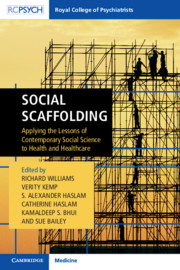Book contents
- Social Scaffolding
- Social Scaffolding
- Copyright page
- Contents
- Contributors
- Foreword
- Note
- Section 1 Schooling
- Section 2 Scoping
- Section 3 Sourcing
- Section 4 Scaffolding
- Chapter 23 Making Connectedness Count: From Theory to Practising a Social Identity Model of Health
- Chapter 24 Public Health Values and Evidence-Based Practice
- Chapter 25 Social Scaffolding: Supporting the Development of Positive Social Identities and Agency in Communities
- Chapter 26 Synthesising Social Science into Healthcare
- Chapter 27 Relationships, Groups, Teams and Long-Termism
- Chapter 28 Caring for the Carers
- Chapter 29 The Importance of Creating and Harnessing a Sense of ‘Us’: Social Identity as the Missing Link Between Leadership and Health
- Chapter 30 Smithtown as Society
- Section 5 Sustaining
- Index
- References
Chapter 30 - Smithtown as Society
from Section 4 - Scaffolding
Published online by Cambridge University Press: 14 June 2019
- Social Scaffolding
- Social Scaffolding
- Copyright page
- Contents
- Contributors
- Foreword
- Note
- Section 1 Schooling
- Section 2 Scoping
- Section 3 Sourcing
- Section 4 Scaffolding
- Chapter 23 Making Connectedness Count: From Theory to Practising a Social Identity Model of Health
- Chapter 24 Public Health Values and Evidence-Based Practice
- Chapter 25 Social Scaffolding: Supporting the Development of Positive Social Identities and Agency in Communities
- Chapter 26 Synthesising Social Science into Healthcare
- Chapter 27 Relationships, Groups, Teams and Long-Termism
- Chapter 28 Caring for the Carers
- Chapter 29 The Importance of Creating and Harnessing a Sense of ‘Us’: Social Identity as the Missing Link Between Leadership and Health
- Chapter 30 Smithtown as Society
- Section 5 Sustaining
- Index
- References
Summary
We developed a fictional town, Smithtown, to support the exercises we undertook during the seminars that gave rise to this book. The town, and a small selection of its inhabitants, were presented to the seminars in 2014, in order to ground the ideas we discussed and focus our conversations about what approaches and actions might assist the population generally and, particularly, following a disastrous flood. We have included a summarised version of it in the book because we thought that readers might wish to think about the implications of the contents of this book for how responsible authorities might approach the challenge of planning for the population of Smithtown. Also, the nature of this fictional town and its recent narrative raises questions for theory, research and practice. Although the town and its inhabitants are entirely fictional, the problems faced by its inhabitants are not..
- Type
- Chapter
- Information
- Social ScaffoldingApplying the Lessons of Contemporary Social Science to Health and Healthcare, pp. 312 - 328Publisher: Cambridge University PressPrint publication year: 2019



